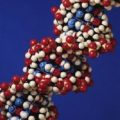
Researchers at the University of Washington (UW) have turned protein folding into a competitive computer game and are hoping to harness the brainpower of gamers worldwide to make medical breakthroughs. Their game, called Foldit, uses people’s natural 3-D problem-solving skills to tackle conundrums in how protein strands curl and twist into three-dimensional shapes.
“We’re hopefully going to change the way science is done, and who it’s done by,” enthused Foldit co-creator Zoran Popovic. “Our ultimate goal is to have ordinary people play the game and eventually be candidates for winning the Nobel Prize.”
Proteins, of which there are more than 100,000 different kinds in the human body, form every cell, make up the immune system and set the speed of chemical reactions. While science understands the genetic sequence of many proteins, we don’t know how they fold up into complex shapes whose nooks and crannies play crucial biological roles.
The intuitive skills that make someone good at playing Foldit are not necessarily the ones that make a top biologist. Baker says his 13-year-old son is faster at folding proteins than he is. Others may be even faster. “I imagine that there’s a 12-year-old in Indonesia who can see all this in their head,” Baker says. Eventually, the researchers hope to advance science by discovering protein-folding prodigies who have natural abilities to see proteins in 3-D. “Some people are just able to look at the game and in less than two minutes, get to the top score,” added Popovic. “They can’t even explain what they’re doing, but somehow they’re able to do it.”
In creating the game, which resembles Tetris on steroids, the developers faced some special challenges that commercial game developers don’t encounter. “We don’t know what the best result is, so we can’t help people or hint people toward that goal,” Popovic explained. The team also couldn’t arbitrarily decide to make one move worth 1,000 bonus points, since the score corresponds to the energy needed to hold the protein in that shape.
Beginning in the fall, Foldit problems will expand to involve creating new proteins that we might wish existed – enzymes that could break up toxic waste, for example, or that would absorb carbon dioxide from the air. Computers alone cannot design a protein from scratch. The game lets the computer help out when it’s a simple optimization problem – the same way that computer solitaire sometimes moves the cards to clean up the table – letting the player concentrate on interesting moves.
Eventually, the researchers hope to present a medical nemesis, such as HIV or malaria, and challenge players to devise a protein with just the right shape to lock into the virus and deactivate it. “Long-term, I’m hoping that we can get a significant fraction of the world’s population engaged in solving critical problems in world health, and doing it collaboratively and successfully through the game,” Baker said. “We’re trying to use the brain power of people all around the world to advance biomedical research.”
Related:
UCLA Announces Breakthrough In Protein Engineering
Proteins Play The Piano
Artificial Proteins Point Way To ‘Synthetic Biology’








Comments are closed.